This is an Akarette II, a 35mm interchangeable lens scale focus camera produced by Apparate und Kamerabau GmbH in Friedrichshafen, West Germany between the years 1950 and 1954. The Akarette II was one of the higher featured models in a lineup of similarly designed cameras from 1947 to 1962. The Akarette is very similar to a later camera called the Akarelle with the most notable difference was the use of a film advance lever on the later cameras. The Akarette II was a well build, but basic camera that offered a variety of lenses in different focal lengths and at different speeds for a lower price than other premium German cameras. Despite having two viewfinder windows on the front of the camera, it does not have a rangefinder, rather the two windows are used for lenses with different focal lengths.
Film Type: 135 (35mm)
Lens: 50mm f/2 Schneider-Kreuznach coated 6-elements in 4-groups
Lens Mount: Akarette Breech Lock Screw Mount
Focus: 1 meter to Infinity
Viewfinder: Twin 50 / 75mm Scale Focus Finders
Shutter: Prontor-S Leaf
Speeds: B, 1 – 1/300 seconds
Exposure Meter: None
Battery: None
Flash Mount: Cold shoe and M and X Flash Sync
Weight: 570 grams, 430 grams (body only)
Manual: https://www.cameramanuals.org/pdf_files/akarette_ii.pdf
Note: This is the second time I have reviewed the Apparate & Kamerabau Akarette II, the first time being part of the Cameras of the Dead series in which I look at cool, but non-functioning cameras. A couple years after writing that first review, I came across this perfectly working camera and after shooting a roll of film in it, I wanted to write an updated review with a bit more history and my thoughts on its use.
In the long list of short lived camera companies is Apparate und Kamerabau GmbH which might perhaps be the most literal name of a camera company because it translates to “apparatus and camera construction”.
Apparate und Kamerabau GmbH, who is commonly abbreviated as AkA, was formed in Friedrichshafen, West Germany in February 1946 by brothers Eugene and Max Armbruster. The company’s first camera was an attractive camera called the Akarette from 1947. This black bodied camera shot 24mm x 32mm images and had an interchangeable lens mount with an in body leaf shutter behind it. The original model is the only one that shoots the smaller image size and is easy to identify as the exposure counter goes up to 40. Unlike most German cameras which used shutters built by Gauthier or Deckel, the shutter on the Akarette was not branded, which suggests it might have been an in-house design.
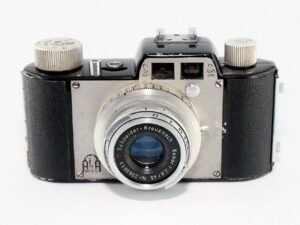
A characteristic of all Akarette cameras (and the later Akarelles) are its two viewfinders, which to someone unfamiliar with the camera might think are for a rangefinder. No cameras in the Akarette or Akarelle series ever came with a rangefinder, instead they had two windows, one each for the 50mm and 75mm lenses which were available. Depending on which lens you had mounted, you’d use the corresponding viewfinder to scale focus your images. Although lenses with focal lengths of 35mm, 90mm, and 135mm would be made for the Akarette, the camera does not have an in body 35mm viewfinder.
The Akarette was quickly updated in 1948 to the Akarette I which increased the exposure size to the more standard 24mm x 36mm size and had some minor cosmetic changes. An accessory shoe was added midway through production of the Akarette I. A simpler model called the Akarette 0 followed in 1949 which removed the switch between the 50mm and 75mm viewfinders, had a black crinkle paint finish, a slower shutter with top 1/200 speed, and a simpler lens.

In 1950 came the Akarette II which upgraded the cosmetics to include chrome top and bottom plates, the switch for the two viewfinders changed from a knob to a lever, and for the first time, the shutter was branded Prontor-S. In addition to changes to the camera, a larger variety of lenses became available, including a top of the line 50mm f/2 Schneider-Kreuznach Xenon. Although still an economically priced camera, the Akarette II offered the option of high quality options, in a German made camera for a fraction the price of other interchangeable lens cameras like the Leica.
I was unable to find any evidence that the Akarette or Akarelles were exported to the United States. I did find evidence that the rangefinder equipped Akarex was imported by an “Akarex Corporation” in New York City, but they did not offer any other camera by the company. Most likely the Akarettes were sold in Germany, UK, and other European countries.
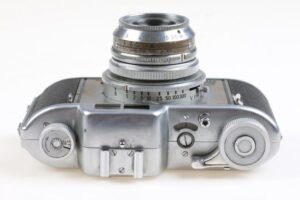
The Akarette would remain in production until 1954 when a revised model called the Akarelle made its debut with the biggest change that it had a film advance lever instead of a knob. A few changes to the lineup of Akarelles include the addition of strap lugs, the addition of a 90mm viewfinder option, and subtle improvements to the film compartment.
AkA would produce the Akarelle until 1957 alongside a series of other cameras including the interchangeable lens rangefinder equipped Akarex, and several simpler scale focus fixed lens Arette cameras. For the Akarette/Akarelle, a total of 26 lenses ranging in focal length from 35mm to 135mm were produced, most by Schneider, but some by Enna Werke München and Isco-Göttingen as well. AkA would remain in business until about 1962 at which time the company disappeared, likely due to an inability to stay competitive.
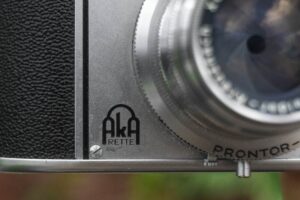
This is my second attempt at a review for the Akarette II, the first as part of my Cameras of the Dead series back in 2020. The camera I used for that review was completely inoperable and was actually the second inoperable Akarette I had come across. Not wanting to continue looking for a working camera, and feeling underwhelmed at its build quality, I gave up and wrote up a short blurb about the camera.
Then, as things often to, without even trying, later in 2023, I came across this cosmetically excellent and perfectly working copy. In addition to being in very nice condition, it also came with the excellent 50mm f/2 Schneider Xenon lens, which optically put the Akarette on part with other top tier German cameras like the Kodak Retina and Voigtländer Vitessa.
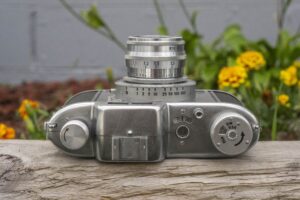
A common issue I’ve observed with both of my earlier Akarettes, plus many I’ve seen online is that whatever finish is applied to the aluminum front plate is very poorly applied and wears off. Many examples of this camera have the logos and markings up front completely worn off, with some having the aluminum plating wearing off entirely revealing bare brass beneath. Even this example reviewed here, while in excellent condition, is already showing early signs of the finish starting to wear away. With repeated use, I am certain it will continue to get worse, so it is worth noting that finding a truly mint condition Akarette/Akarelle is extremely difficult. Strangely, some of the simpler models like the Akarette 0 seem to hold up better.
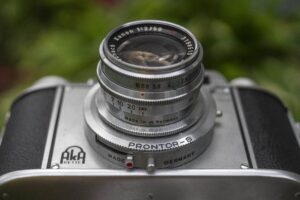
While this was an economically priced camera with questionable cosmetics, the Akarelle still manages to have a high quality feel to it. Its all metal body has some heft weighing in at 570 grams, putting it on par with a Leica III of the same era. The inclusion of the large front element from the Xenon lens certainly adds to its appeal, but the camera’s soft rounded corners not only add to its ergonomic feel, but also gives it a bit of an elegant look. I quite enjoyed the feeling of the camera while playing with it.
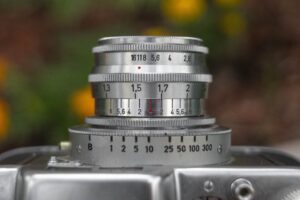
Despite the inclusion of a very good lens, the Akarette was a simple camera and the control layout reflects that. All of the camera’s critical controls are in obvious locations. Anyone who has shot a mid century 35mm camera should have no problem picking one up and using it immediately. There’s really only two oddities, the first of which is how to rewind film after you finish a roll. Unlike many cameras with a button or a lever that must be used to deactivate the film transport, on the Akarette, you simply lift up on the wind knob and give it a quarter turn in the opposite direction of the arrow to lock it in the up position. With the knob in this position, you can use the small rewind knob on the opposite side to rewind your film.
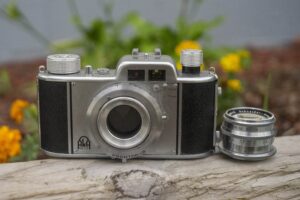
The second oddity is in the lens mount. The Akarette is technically a screw mount, but unlike a Leica or M42 SLR in which the lens simply rotates off, here the lens doesn’t rotate, but rather a ring around the base of the lens mount does. I refer to this as a “breech lock screw mount”. If that’s confusing, think of a Canon FL or FD mount camera in which you have to twist a breech lock bayonet in order to release the lens, but rather than a quick twist of a bayonet, the entire ring must be rotated about 3 full revolutions to unscrew the lens. It is a very slow and inelegant system, and one I wish I could go back in time and ask whoever came up with it, what they were thinking. A simple screw mount would have been easier.
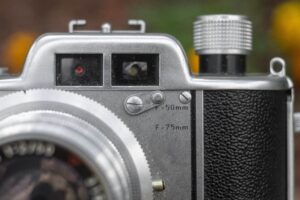
As explained above, the Akarette has two viewfinders, one for 50mm and one for 75mm. Later lenses in the Akarette mount were 35mm, 90mm, and 135mm, which would require auxiliary viewfinders, but for most people, the 50mm is the one most likely to be used.

Loading film into the camera is quite easy. The entire back is hinged, but it also includes half of the top plate including the accessory shoe. This means if you have an auxiliary viewfinder or an exposure meter clipped onto the camera, it will move with the door. Beyond that, film loads normally from left to right onto a fixed take up spool. Sprockets above and below the film gate ensure that it transports correctly and a large pressure plate with divots, reduces friction as film passes over it. The Akarette has very deep channels around the door and predates the use of light seals so there is no foam or cloth that can deteriorate and cause light leaks.
After my first two experiences with an Akarette resulting in a dead camera and having this example which was both in excellent cosmetic condition but also perfect working order, I was eager to finally see what this camera could do. For its first roll, I loaded in a roll of slightly expired Fuji Neopan 400 and took it out shooting.
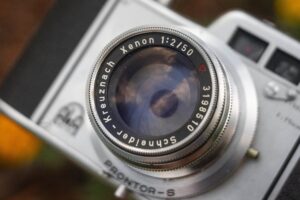
The Schneider-Kreuznach Xenon lens was a highly regarded German optic which could be found on a large number of cameras. I personally have Kodak Retinas with them, I have one in an Ihagee Exakta mount, and I have a Welta Weltini II with one. The quality of the images from these lenses should be as good as any, but strangely, the example here seemed to struggle with contrast and show a tiny bit of vignetting in the corners. The contrast issue could possibly be a result of the expired Neopan film, or perhaps a tiny bit of haze inside the lens, but I can’t explain the vignetting. I didn’t shoot the lens with a hood or filter on, so it is not that. Perhaps there’s some kind of shadowing happening inside the film gate of the camera.

That aside, I still liked the images I got from the Akarette. If anything, the less than perfect image quality gives these photographs more character that a technically perfect lens would have. More so than the image quality, I really enjoyed shooting the Akarette. Leaf shutters are well known for being quieter than focal plane shutters, but sometimes can be too quiet. The Prontor-S shutter here has that perfect balance of a crisp “snick” as the shutter fires, without letting the whole world know you just snapped a photo. The shutter action is satisfying as is the simple viewfinder. Looking at the gallery above, with the exception of my mirror selfie and the drive thru photo, I shot everything else at infinity, so I didn’t need to worry about focus too much. Although not pictured, for this roll, I did have a Doomo Meter S mounted to the accessory shoe to help me with metering, and that worked really well, especially in the indoor scenes.
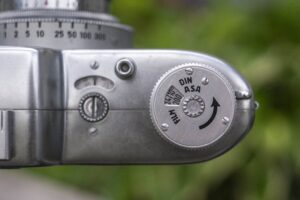
There were a ton of 35mm cameras made in the mid 20th century and there aren’t a lot of differences between many of them, but for the Akarette, the camera’s unique shape and streamlined soft corners gave it a luxurious feel which made the camera appear to be smaller than it really is. I found the act of holding the camera to be very pleasant and something that I don’t always get from every camera I handle. If the Argus C3 is a brick with sharp corners, the Akarette is a jelly bean…but in the best way possible.
My list of cons firmly fit into the nit pick category. I didn’t love how opening the film compartment included half of the top of the camera. It feels like this unnecessary weight could one day wear down the door hinge, causing light leaks. I didn’t quite love the position of the shutter release, as it was too close to the tall film advance knob, causing my finger to contort into an imperfect position, and I wasn’t a fan of the lens mount, however since I only have one lens in the Akarette mount, I only ever had to take it off for photos for this review.
Related Posts You Might Enjoy
External Links
http://camera-wiki.org/wiki/AkArette
https://www.collection-appareils.fr/x/html/appareil-1780.html


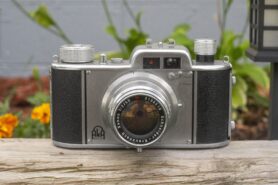
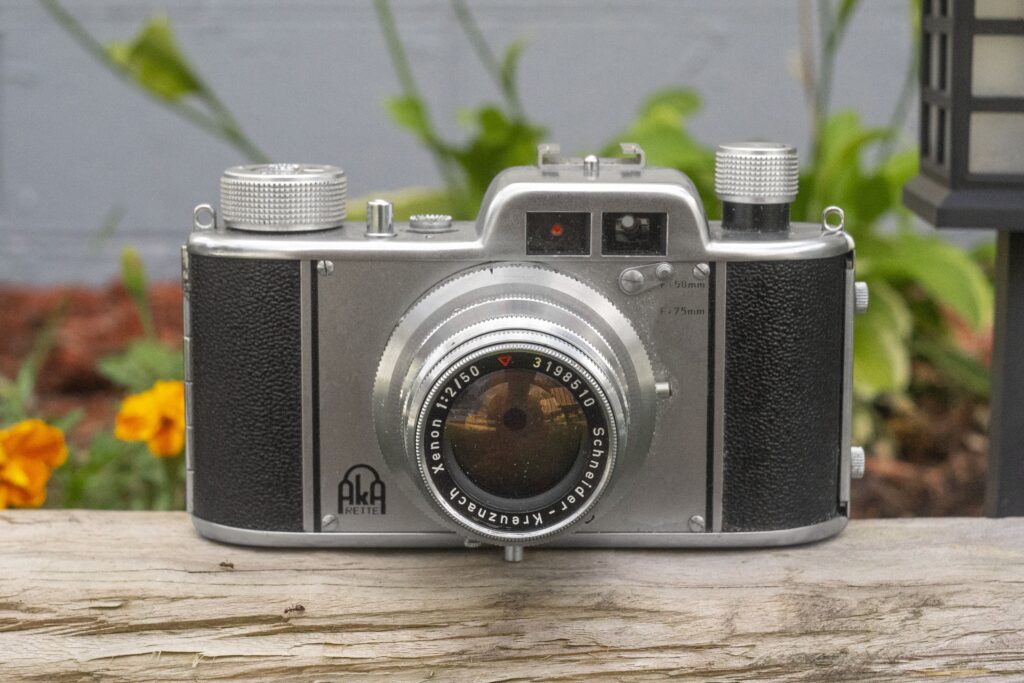
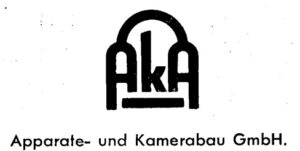











I am not sure how many Akarettes of the first type (24X32-same as first Nikon and Minolta) that AkA ever made. I own #175 and it is in the 24×36 format. Lovely little camera with nice handling. The Schneider optics for this camera are very nice. This is a systems camera with many accessories. Note that the Lordomat and the Diax used similar designs for their lens mounts—what I would call a screw-breechlock. For further information, check out my blog entry: https://wesloderandnikon.blogspot.com/2021/05/akas-akarette-and-akarelle-compact-35mm.html and https://wesloderandnikon.blogspot.com/2021/05/the-object-at-hand-copy-stand-device.html. Cheers
I did not realize that so few were made to shoot 24×32. I guess I assumed it was a pretty large number. It does not seem likely that I will ever come across one!